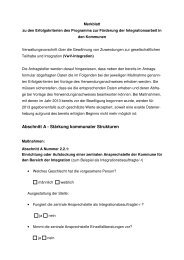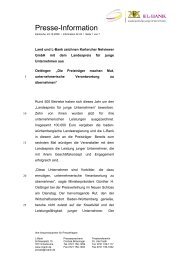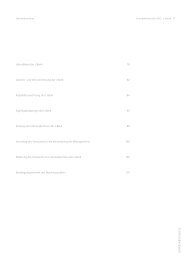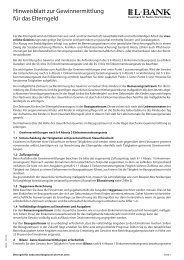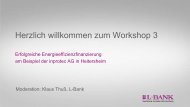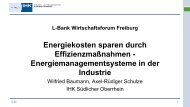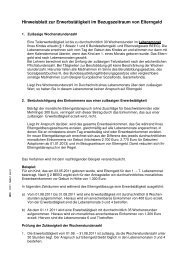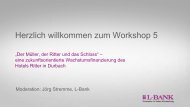Landeskreditbank Baden-Württemberg - L-Bank
Landeskreditbank Baden-Württemberg - L-Bank
Landeskreditbank Baden-Württemberg - L-Bank
Create successful ePaper yourself
Turn your PDF publications into a flip-book with our unique Google optimized e-Paper software.
Notes to the annual financial statements for<br />
the financial year ended December 31, 2004<br />
Securities in the trading portfolio and liquidity reserve are valued strictly according to the principle of<br />
lower of cost or market value as at the balance sheet date. Securities treated as fixed assets are shown at net book<br />
value, differences between book value and redemption value (i.e. premiums or discounts) being marked up or<br />
down pro rata to term.<br />
Equity investments in non-affiliated and affiliated companies are valued at the lower of acquisition cost<br />
or – where the value is expected to continue to decline – value at the balance sheet date, according to the rules<br />
applying to fixed assets.<br />
Intangible assets and tangible assets are valued at acquisition or production cost, less scheduled<br />
depreciation. Where the value of an item is expected to continue to decline, unscheduled depreciation has been<br />
applied as appropriate. Minor fixed assets are fully depreciated in the year of acquisition.<br />
Reserves for pension commitments and for obligations under the <strong>Bank</strong>’s employee pension scheme<br />
have been calculated using the method of computation provided for in § 6a of the German Income Tax Act<br />
(Einkommensteuergesetz [EStG]) applying the updated Heubeck mortality tables (Heubeck Sterbetafeln).<br />
Adequate provisions have been made to cover the early retirement scheme provided for by collective agreement<br />
and the part-time employment scheme devised for employees approaching retirement, as well as any obligations<br />
arising in connection with long-service bonuses and other benefits.<br />
Other reserves are set at the amount deemed necessary by the exercise of reasonable business judgment<br />
to cover all uncertain liabilities and potential losses on pending transactions. The option of setting up reserves for<br />
operating expenses, as provided for under § 249 para. 2 HGB, has been exercised.<br />
The <strong>Bank</strong> concludes derivative transactions primarily in order to control interest rate exposure – they<br />
are not valued. The <strong>Bank</strong> also trades in derivatives on its own account and in order to hedge balance sheet items.<br />
Market values are based on the interest rates prevailing at December 30, 2004, being the last day of the year on<br />
which there was a liquid market. Transactions for hedging purposes are valued together with the relevant balance<br />
sheet items.<br />
The market values of bonds, notes and derivatives held for the <strong>Bank</strong>’s own account are determined<br />
individually as at the balance sheet date. After closing two portfolios in 2004, the <strong>Bank</strong> currently holds two<br />
portfolios governed by EUR interest rate risks and offsets valuation gains and losses within these portfolios. In<br />
accordance with the non-parity principle (Imparitaetsprinzip), any positive balance is not appropriated, whereas a<br />
provision is made to cover a negative balance.<br />
Principles of the German <strong>Bank</strong>ing Act (Kreditwesengesetz [KWG])<br />
Throughout 2004, the <strong>Bank</strong> complied with Principle I (relating to capital adequacy) and Principle II (relating to<br />
liquidity) as required by the German <strong>Bank</strong>ing Act (Kreditwesengesetz [KWG]).<br />
F-9



